Want to add more ecommerce channels to your online marketing strategy but not sure where to start? You’re not alone. The fact is, there really are no one-size-fits-all set of channels that will work for every business. And with thousands of channels at your fingertips, it can be a challenge to filter through all of your options and to know which are worth testing. This is why, before looking at the channels themselves, you should first look at your business’s marketing objectives and what you’re aiming to achieve.
Is your business looking to:
- Attract prospects as they search
- Re-engage your past customers
- Reach out to totally new prospects
- Increase traffic quantity and/or quality
By focussing on your ideal results, finding the right channels can be made much simpler. You see, ecommerce channels don’t all work the same or even cater to the same audience. While some are great for reaching shoppers who are actively searching for a product, others work well for reaching shoppers who have previously interacted with your online shop. There are even channels designed to spark interest in shoppers who aren’t looking for a product at all!
Moreover, in order to stay ahead of the competition and maximize online product visibility, brands and online retailers need to meet their consumers at every relevant touchpoint. This means you need to leverage several ecommerce channels.
All of that said, there are seven common channel types that all work well for different marketing objectives. Read on to find out which are best suited to your business.
Which type of ecommerce channels are available?
Search engines

Search engines are a tool used primarily for pull marketing strategies, which means they are best to capture your lowest hanging fruit, as you will be visible for people who are actively looking for a product. These shoppers are already interested and tend to convert quicker.
Search engines like Google and Bing offer several different types of advertising possibilities including paid search text ads, image ads, sponsored product listings (i.e. Google Shopping), and voice search marketing.
These channels can also be included in your push marketing strategy via Display ads, which are available in Google Ads. This can be a great way to introduce your product to a new audience.
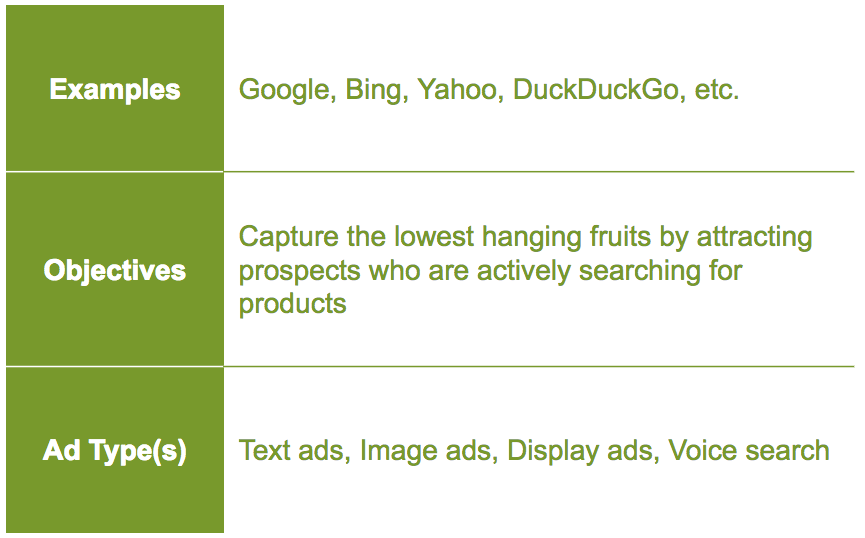
Online marketplaces

Another great way to capture the attention of shoppers who are actively searching is through online marketplace listings and advertising. According to Statista, 44% of US internet users made a purchase from an online marketplace in 2018. Marketplaces allow shoppers to sift through tons of products from a variety of different categories and can be visualized as a digital department store.
Marketplaces are designed to help online retailers acquire more traffic and product sales, whereas resellers have to deal with logistics which gives them less time to spend on advertising. Moreover, online marketplaces let you keep control over your product information, including the price.
While Amazon and eBay are among the most popular online marketplaces, they can be extremely competitive in certain product categories and may not work best for every business. Therefore, you may need to pick out smaller, more niche, maybe even local marketplaces that are still growing. This may allow you to gain more visibility and sales at a much lower cost.
Then there are mobile marketplaces. These are online marketplace apps that are designed to capture mobile shoppers. Some examples of native mobile marketplaces are Wish and Lyst.
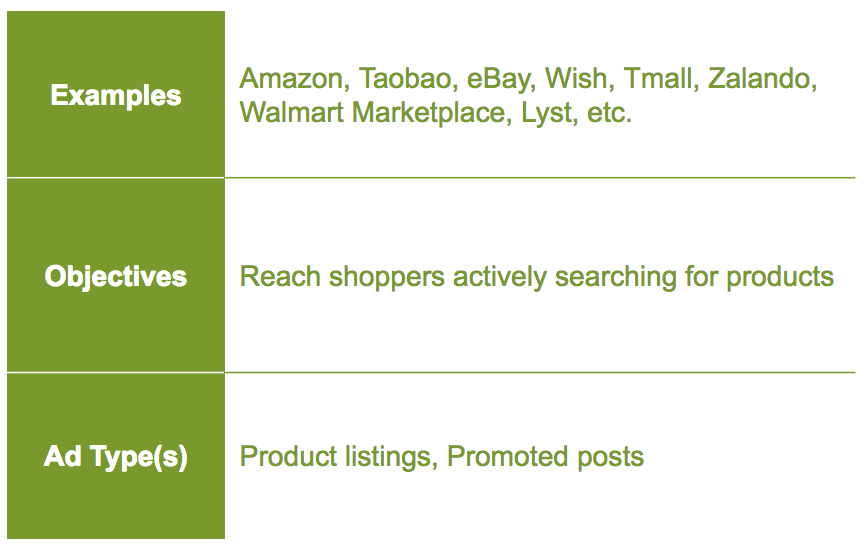
Comparison shopping engines

If your products are competitively priced or if price matters a lot to shoppers of your product, one of the best channels may be comparison shopping engines, as shoppers on these sites are actively looking for good deals. Here, retailers can list their products to be displayed alongside the same products listed by other sellers, giving shoppers a clear picture of the best deal. In order to win these sales, it will be important to regularly monitor your competition’s pricing.
Once a shopper clicks on an advertiser’s offer, they are sent directly to the retailer website where they can complete the transaction.
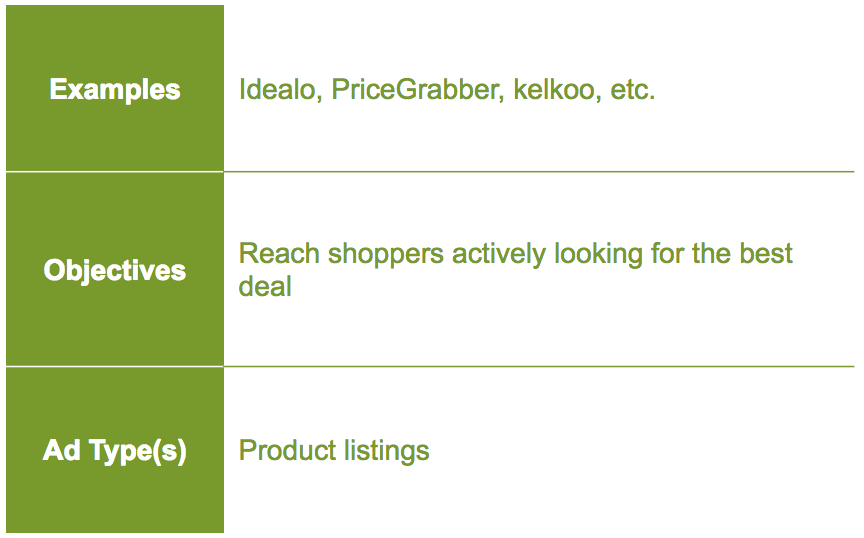
Email marketing
Email marketing is another great way to capture the lowest hanging fruits or shoppers most ready to convert. Since these users have already provided you with their email address, they are much more likely to make a purchase from you in the future.
With email marketing, you can send different messages based on behavior-based triggers. For example, shopping cart abandoners may get a reminder, while shoppers who have a birthday might get a discount voucher. You could even take it one step further and create a complete nurturing campaign that acts as a funnel turning browsers into buyers.
Read more on email automation best practices here.
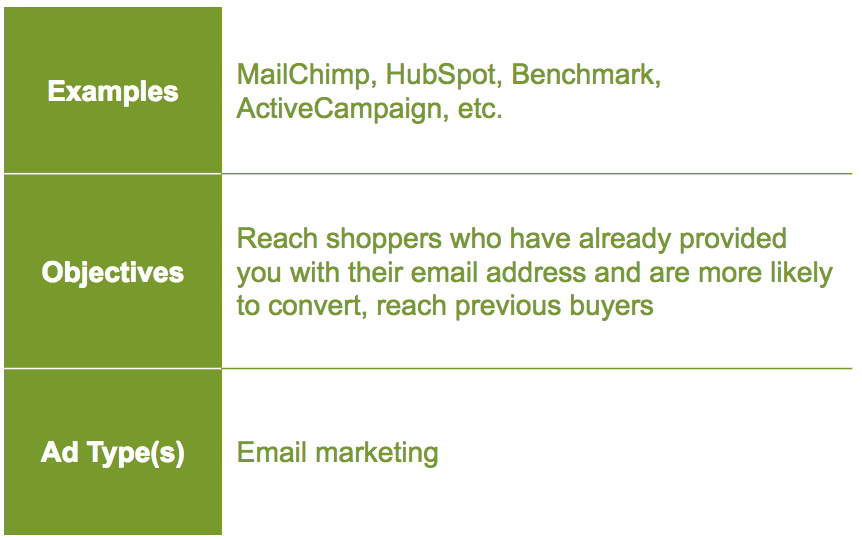
Retargeting networks
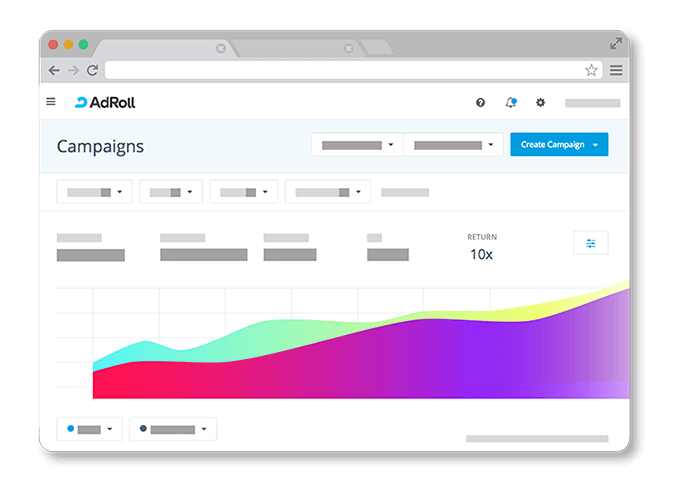
According to SaleCycle, the average shopping cart abandonment rate for retail websites in 2019 was 84.27%. That’s a lot of missed revenue! But it's also the reason why remarketing exists.
Retargeting allows advertisers to target shoppers who have previously visited their website. Since there are many reasons why shoppers abandon their cart, it's rarely a lost opportunity. Many of these shoppers are often still interested and were simply distracted, so they’re easier to convert.
Remarketing can be set up through a retargeting network like AdRoll or Criteo, but is also offered by channels like Google and Facebook. Depending on the channel, a unique tracking pixel will likely need to be integrated on to the advertiser's website. Previous site visitors will then be served ads later on when visiting other websites.
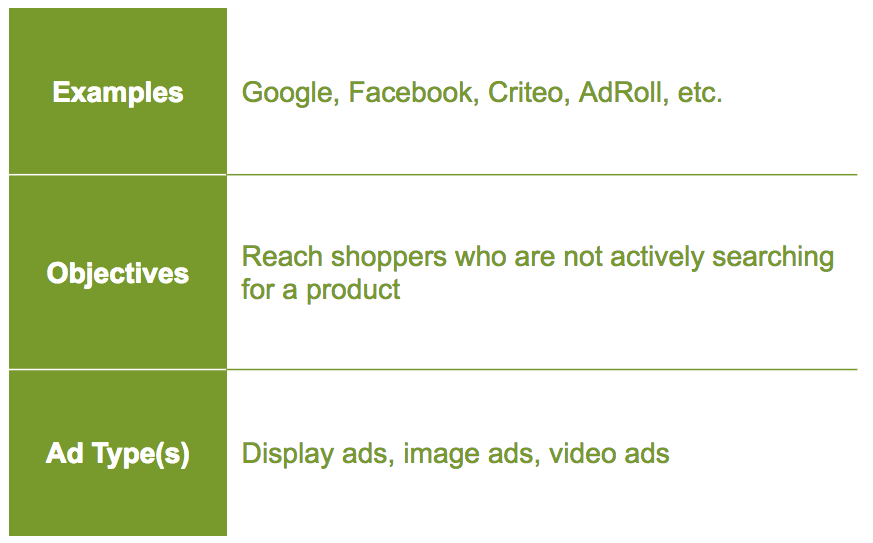
Social networks
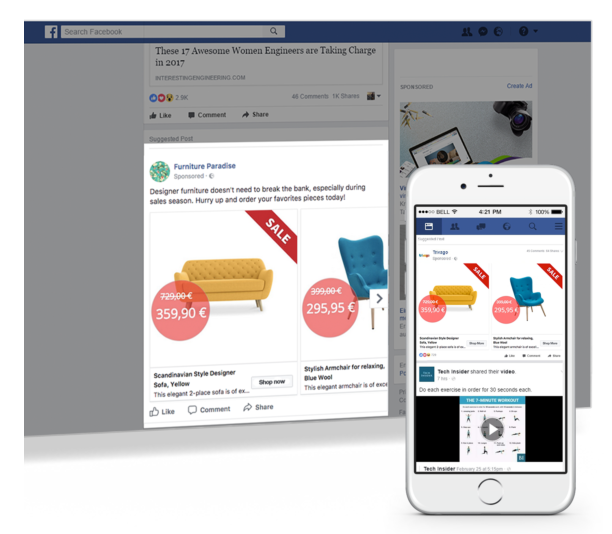
Millions of people from around the world use social networks on a daily basis. As their popularity continues to grow, so does the number highly-lucrative advertising and retargeting opportunities they provide. It is now easier than ever to turn social platforms into selling platforms. Today this is called social commerce.
One of the reasons why social media is so powerful is just how granular they can get with targeting. Facebook, for example, allows you to target users on very specific lifestyle and behavioral patterns. Its Dynamic Ads algorithm goes one step further and ensures the right product is always shown to the right user and at the right time. Here, Facebook users are retargeted based on many different steps in the sales funnel, for example, people who previously abandoned their cart. We've written about Facebook targeting tactics here.
Other social networks, like Pinterest, cater to an inspiration-seeking audience. Here, advertisers can reach an audience who may not actively be looking for a product but are certainly open to new ideas.
In any case, advertisers who take the time to adapt their message to a social network's audience see great success on these channels.
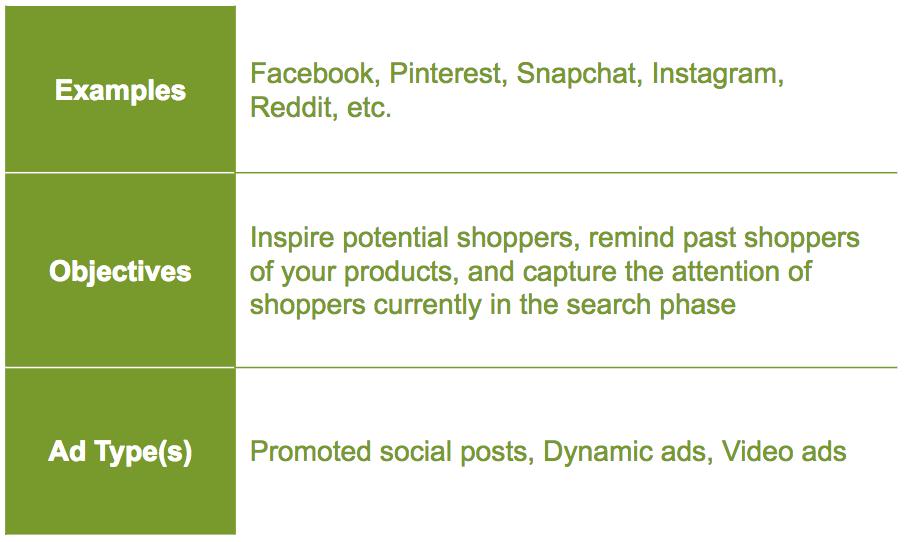
Affiliate networks
Affiliate networks are essentially the middleman between publishers and advertisers. An affiliate publisher can be anything from a price comparison engine or shopping directory to a blog or reward website.
The wide variety of websites and channels accessible through affiliate networks makes them a good choice for retailers looking to diversify their traffic sources, expand their audience, or increase the quality of their online traffic.
Affiliate networks allow advertisers to submit their product data feed to a centralized platform, where publishers can select products to promote on their websites. A fixed commission rate is set between the advertiser and publisher for whenever a click, sale, or generation of a lead takes place.
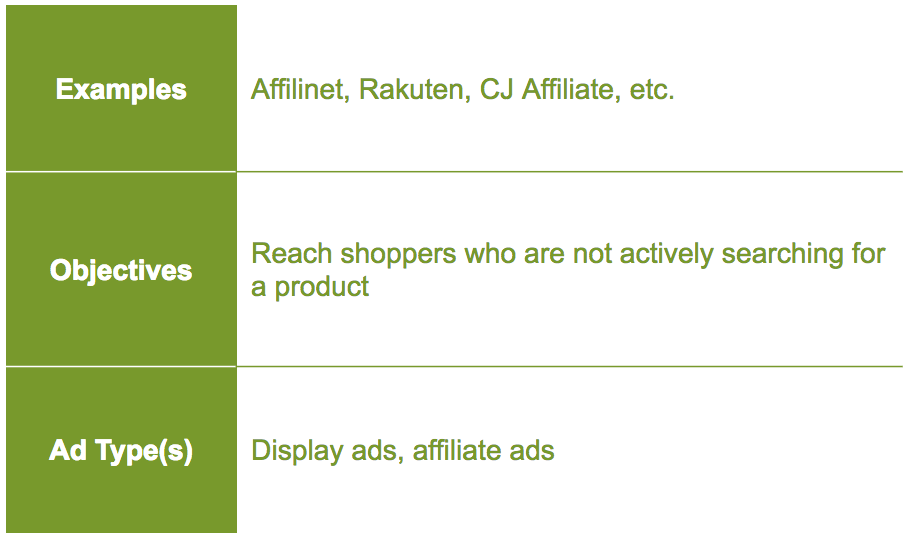
Which ecommerce channels are best suited for your business?
While this may seem like a lot of channel types, keep in mind that there are thousands of individual channels that fall under each category. Examining every aspect of each channel would take ages, therefore, remember to focus primarily on your main marketing objective. In addition to defining your key goal, you can narrow down your channel search by asking yourself the following questions:
- __Who is your target audience, are they on a specific channel? __If so, what level of targeting flexibility does the channel offer to you?
- __Where are your competitors?__ Which channels are they using?
- __What is your marketing budget?__ If you’re starting out with a lower budget, start out with channels that will enable you to capture the lowest hanging fruits (i.e. retargeting and search channels).
- __What are your available resources and what is your time frame?__ Text ads require fewer resources than display or video ads, however, they still need to be optimized. Good feed management software can help you manage a large number of channels, without spending excess time and resources on manual tasks or support from IT.
By answering these questions, you’ll be able to decipher between relevant and irrelevant ecommerce channels for your business. Then, you can start testing.
Test new channels, create product feeds quickly
Once you’ve narrowed down the list of potential ecommerce channels that could work for your business, the only true way to determine their value is to test the waters. Try listing or advertising only a few best-selling products before sending off your entire product inventory and just see what happens. This will ensure you won’t waste excess time or resources.
Without a feed management solution, it can be challenging and time-consuming to prepare even a single product feed for export. Of course, this can make testing near impossible. Powerful software, like Productsup, can give your business the agility required to test and leverage new channels within just hours. You’ll also be able to compare channel performance through a centralized reporting tool.
With 2500+ integrated export channel templates, Productsup provides you with the tools necessary to assess channel readiness, transform product data to match any channel’s requirements and provide a seamless shopping experience across all digital shelves.
This updated post was originally published on May 14, 2019.

